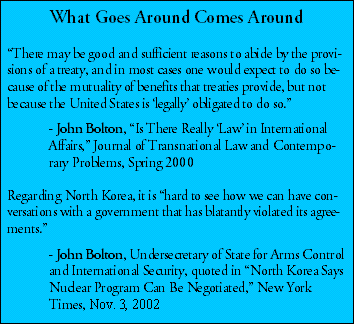Nonproliferation Treaty
Applies to Both North Korea and the United States |
||||
| The Nuclear Nonproliferation Treaty (NPT) is much in the news due to North Korea’s January 10, 2003 announcement of withdrawal. What has received no attention is that the United States is also undermining the NPT by ignoring recent political commitments to implement the treaty’s disarmament obligation. The NPT and North Korea North Korea’s violations of the NPT, in the early 1990s, and again
now, consist at least in operating programs for production of plutonium and perhaps
uranium that are not monitored by the International Atomic Energy Agency (IAEA) to prevent
diversion of the materials to weapons. Accordingly, in February, the IAEA reported to the
Security Council that North Korea is in breach of the NPT. It is not known whether North
Korea has produced any nuclear explosive devices with unaccounted for plutonium from its
earlier program, which of course would violate the NPT’s basic non-acquisition
obligation. According to North Korea, its announcement of withdrawal from the NPT was effective immediately. However, as the IAEA has recognized, under the treaty’s terms it becomes effective only on three months notice. Moreover, and fundamentally, while North Korea may be able to withdraw from the treaty, it cannot withdraw from the underlying obligation not to acquire nuclear weapons. First, NPT general obligations are now sufficiently settled, accepted, and longlasting to be customary international law, binding on all states whether or not they are parties to the treaty. The NPT has been in force since 1970, and its membership is nearly universal, with only three states outside the regime, all, however, nuclear-armed, India, Pakistan, and Israel. Second, the NPT is widely recognized, along with the UN Charter, as a cornerstone of global order. In its resolution on the May 1998 Indian and Pakistani nuclear tests, the Security Council declared that proliferation of weapons of mass destruction is a threat to peace and security. Under Chapter VII of the UN Charter, that means, in principle, that the Security Council is required to respond to any state’s efforts to acquire nuclear weapons, at least by making recommendations as to how to reverse such efforts. Third, based in part on the incompatibility of threat or use of nuclear weapons with humanitarian law forbidding the infliction of indiscriminate harm and unnecessary suffering, the International Court of Justice, interpreting NPT Article VI, concluded unanimously in its 1996 opinion that states are obligated to bring to a conclusion negotiations on nuclear disarmament. The clear implication is that the obligation of non-possession of nuclear arms is universal in scope; that states therefore are not to acquire nuclear weapons; and that possessor states are obligated to eliminate them with all due speed. None of this is to say that the Security Council should respond to a North Korea nuclear weapons program by authorizing use of force. Security Council practice indicates that use of force is a permissible response only to actual or imminent attacks, large-scale violence, or humanitarian emergency. (See Appeal, p. 6) There is no legal basis for U.S. military action. A political approach combining censure with dialogue, inducements, and, perhaps, limited sanctions is the right course of action. The NPT and the United States To balance obligations, Article VI of the NPT requires the nuclear powers to "pursue negotiations in good faith on effective measures relating to cessation of the nuclear arms race at an early date and to nuclear disarmament." In 1978 and again in 1995, the United States and other nuclear powers also formally declared policies of non-use of nuclear arms against non-nuclear NPT states. In the post-Cold War era, non-nuclear countries have demanded progress on the promised disarmament. In 1995, the year that the NPT was due to expire, the United States and other nuclear states pressed for the treaty to be extended indefinitely. Other states agreed in return for pledges to complete negotiations on a treaty banning all nuclear test explosions by 1996, to begin negotiations on an agreement banning production of plutonium and highly enriched uranium for use in weapons, and to pursue "systematic and progressive efforts to reduce nuclear weapons globally, with the ultimate goal of eliminating those weapons." Additional commitments made in 2000 include "an unequivocal
undertaking to accomplish the total elimination of their nuclear arsenals,"
preserving the ABM Treaty, applying the principle of irreversibility to nuclear weapons
reductions, further developing verification capabilities, reducing the operational
readiness of nuclear weapons, and a diminishing role for nuclear weapons in security
policies. Measured against the standards set in 1995 and 2000, the nuclear powers, especially the United States, are not complying with the disarmament obligation. The Senate declined to approve ratification of the Comprehensive Nuclear Test Ban Treaty in 1999. Negotiations on a fissile materials treaty are stalled. The United States withdrew from the ABM Treaty in June 2002. Perhaps most disturbingly, the Defense Department’s Nuclear Posture Review submitted to Congress at the end of 2001 signals the end, or at least the suspension, of verified and irreversible arms control. In accordance with the Nuclear Posture Review, the short and starkly simple Moscow Treaty signed in May 2002 with Russia does not require the verified destruction of any delivery systems or warheads. In addition to treaty-permitted deployed strategic warheads, 1700-2200 in 2012, the Defense Department plans to retain many thousands of warheads in reserve. That includes large numbers – probably more than 2000 a decade from now - in a "responsive force" capable of redeployment within weeks or months. A more blatant rejection of the NPT principle of irreversible arms control could hardly be imagined. Nor is there any indication in the Nuclear Posture Review or elsewhere that the Bush administration will seek to reduce the readiness level of deployed strategic forces, for example by separating warheads from delivery systems. Today, both the United States and Russia each have about 2,000 warheads on high alert, ready to launch within minutes of an order to do so. The Nuclear Posture Review also ignores the commitment to reduce the military role of nuclear weapons and the longstanding assurances of their non-use against non-nuclear countries. Instead it reveals new trends towards making nuclear arms more usable, notably in response to non-nuclear attacks or threats involving biological or chemical weapons or "surprising military developments." Among the "immediate contingencies" it identifies for possible U.S. nuclear use is "a North Korean attack on South Korea" - not necessarily a nuclear attack. Indeed, the reference to use of nuclear weapons against North Korea was one of a series of provocative Bush administration statements spurring North Korean nuclearization. They include naming North Korea as a member of the "axis of evil"; strategy documents embracing "preemptive" military actions against states’ acquiring of nuclear, chemical, biological, and radiological weapons; and depiction of a potential future North Korean missile deployment as a major basis for withdrawal from the ABM Treaty. Resolving the Crisis The right and lawful thing for North Korea to do is to abandon any aspirations for a nuclear arsenal and to remain a member of the NPT. For its part, the United States should provide a formal assurance that it will not use nuclear weapons against North Korea. That step follows from the U.S. commitment already made to all non-nuclear weapon NPT states, and also was promised as part of the 1994 U.S.-DPRK agreement. The United States should also end the state of near war that has existed between the two countries for decades and normalize relations, including economic relations. That is fundamentally what North Korea seeks. More broadly, if North Korea’s hopefully temporary defiance of the NPT is to remain an aberration not imitated by other countries, the United States will have to learn that a viable nonproliferation regime depends crucially on compliance with the obligation to disarm nuclear weapons as well as the obligation not to acquire them. John Burroughs, LCNP executive director, is the principal author of the chapter on the NPT in Rule of Power or Rule of Law? An Assessment of U.S. Policies and Actions Regarding Security-Related Treaties (New York: Apex Press, 2003). Another version of this article appeared January 27, 2003 in History News Network, www.hnn.us.
|
||||

